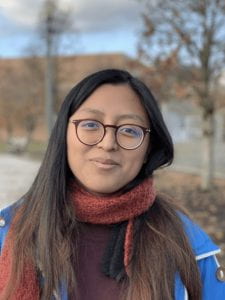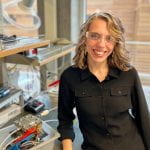
Category: Grad Student Spotlight
2024 Graduate Student Community Builder Award
We are pleased to announce that Ashley Mapile and Harrison Reid have been awarded this year’s Graduate Student Community Builder Award.
Both Ashley and Harrison have supported an inclusive, supportive, collaborative, and respectful environment within our Department.
Ashley is recognized for important work with the department DEI committee and REU program, among other activities. She is a member of the Richmond/Scatena and Brozek Labs.
Harrison’s award is in recognition of his efforts in organizing community participation in SACNAS and the Catalyst mentoring programs. He is a member of the Jasti Lab
Biochemistry doctoral student Justin Svendsen’s start-up project a finalist in LCB’s Oregon Innovation Challenge
Gaby Bailey receives 2023 NSF Graduate Research Fellowship Award
 UO Chemistry graduate student Gaby Bailey has been selected to receive a National Science Foundation Graduate Research Fellowship. Gaby is a 2nd year doctoral student in the Jasti Lab.
UO Chemistry graduate student Gaby Bailey has been selected to receive a National Science Foundation Graduate Research Fellowship. Gaby is a 2nd year doctoral student in the Jasti Lab.
Gaby’s Research: The Jasti lab synthesizes cycloparaphenylenes (CPPs) which have unique optical properties. Gaby’s project involves systematically altering the size, electronic modulating groups, and the strain induced on these electronic modulating groups to study the effects on the fluorescence emission of these materials. This information will further inform on how to tune the optical properties of CPPs. Brightly fluorescent materials with tunable optical properties can be envisioned to play a role in biological imaging as well as in new light emitting materials.
About the Award: The NSF Graduate Research Fellowship Program (GRFP) seeks to ensure the quality, vitality, and diversity of the scientific and engineering workforce of the United States. The program recognizes and supports outstanding graduate students in NSF-supported science, technology, engineering, and mathematics disciplines who are pursuing research-based master’s and doctoral degrees at accredited United States institutions. Fellowships provide the recipients with a three-year annual stipend of $37,000 along with a $12,000 cost of education allowance for tuition and fees (paid to the institution), as well as access to opportunities for professional development available to NSF-supported graduate students.
Lab Spotlight: Willow Davis in the DWJ Lab
Watch Willow in this video as she shares about her research in the Darren Johnson lab!
Kalika Pai awarded NSF Graduate Research Fellowship
 UO Chemistry graduate student Kalika Pai has been selected to receive a National Science Foundation Graduate Research Fellowship.
UO Chemistry graduate student Kalika Pai has been selected to receive a National Science Foundation Graduate Research Fellowship.
The fellowship honors and supports outstanding students pursuing research-based graduate degrees in NSF-supported STEM disciplines at accredited US institutions. Recipients receive three years of financial support including an annual stipend of $34,000, as well as access to opportunities for professional development available to NSF-supported graduate students. In addition, the fellowship provides the institution with a $12,000 cost of education allowance for tuition and fees.
Kalika is a second-year graduate student in the Widom lab. Her research involves using single-molecule fluorescence methods to determine the kinetics of binding between short oligonucleotides and structured RNA molecules. These “fingerprints” will then be used in experiments that probe the structure of biologically relevant RNA.
Kalika’s broader impacts goals are focused on promoting science literacy in middle/high school students, and increasing the accessibility of science to underrepresented groups. She plans to work with local schools to bring hands-on, relevant STEM activities directly to the classroom, in hopes of reaching students that would not have sought out opportunities for these kinds of experiences themselves.
Chemistry grad student Grace Lindquist featured in ACS Energy Letters series ‘Women Scientists at the Forefront of Energy Research’
Chemistry grad student Bella Demachkie featured in article on women in STEM
Brozek Lab in the News!
Emma Tran and Grace Lindquist receive 2021 Keana Fellowships
UO Chemistry and Biochemistry graduate students Emma Tran and Grace Lindquist have been named as the department’s 2021-22 John Keana Fellows. Emma is in her fifth year of the chemistry doctoral program, working in the Richmond Lab. Grace is a fourth-year doctoral student and works in the Boettcher Lab.
The Keana Fellowship was established in 2017 in honor of Professor Emeritus John Keana, and provides annual fellowship awards to graduate students studying in the Department of Chemistry and Biochemistry at the University of Oregon. The award may be used to assist with defraying the academic costs associated with attending the university such as tuition, fees, books, miscellaneous supplies, research and living expenses.
We asked Emma and Grace to tell us a little about themselves and their science.
Emma Tran
I was born in Vietnam, but grew up mainly in Las Vegas, Nevada. There, I completed my Bachelors of Science degree in Chemistry with a minor in Mathematical Sciences. While juggling coursework, waitressing, and tutoring, I only got to dabble briefly in chemistry research. It wasn’t until I started graduate school at the University of Oregon that I gained more experience and insight into scientific research. As I progressed through my graduate school career, my interest in research grew as I gained a deeper appreciation for science communication, chemical education, mentorship, and the efforts toward improving the representation of underrepresented groups in science.
About her research
I am currently conducting research in Dr. Geraldine Richmond’s lab, investigating the interfacial phenomena of oil-in-water nanoemulsions. Through various experimental techniques such as pendant drop tensiometry, dynamic light scattering, and vibrational sum frequency scattering spectroscopy, I study the surface chemistry, behavior, and properties of biocompatible and environmentally friendly emulsifiers. The insight and fundamental knowledge gained from my research aims to guide the rational design of tunable drug delivery systems and safer oil remediation methods.
Future plans
I am planning to defend and graduate with my PhD in Spring 2022, and currently exploring and considering several career trajectories, hoping to broaden my skill sets and research breadth. My long-term goal is to become a professor at a primarily undergraduate institution while establishing strong partnerships with neighboring national labs and/or industry collaborators.
Grace Lindquist
I grew up in Detroit Lakes, Minnesota and attended the College of Saint Benedict and Saint John’s University in central Minnesota. At St. Ben’s I was a part of the FoCuS program which was aimed at increasing gender and racial diversity in STEM majors. I was on an accelerated course path and took every class with the same group of women, some of which are still my closest friends. Having a constant support network in chemistry really helped me succeed as a chemistry major and encourage me to pursue my PhD. As a grad student here at UO, I am heavily involved in outreach. I lead Mad Duck Science, a program that conducts science experiments with students from a local, under-funded middle school. I am also an outreach coordinator for Women in Graduate Science, where I help organize various activities throughout the community to encourage young girls to pursue degrees in STEM.
About her research
In the Boettcher lab I research anion exchange membrane water electrolysis. It is a growing technology that, with further development, has the potential to compete with current mature electrolyzer technologies. Water electrolysis is a carbon-emission-free process that produces hydrogen renewably, which is key to supporting the transition to a clean energy economy. I love my research because I work at the interface between fundamental and applied science. It’s very inspiring to get to see the direct impact my results have on improving renewable energy technology.
Future plans
I plan to pursue a postdoctoral position to expand my understanding of electrochemical energy technology, after which I hope to work in a position where I can maximally impact society through research, outreach, and science policy advocacy and development.




